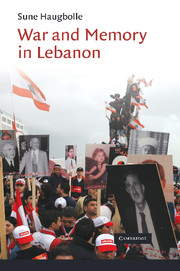Book contents
- Frontmatter
- Contents
- Figures
- Acknowledgments
- Note on Transliteration
- Acronyms
- War and Memory in Lebanon
- Prologue: A Hiatus of History
- 1 Remembering a War of Selves and Others
- 2 Culture, Politics, Civil War
- 3 Discourses on Amnesia and Reconstruction: Memory in the 1990s
- 4 Nostalgias
- 5 Inside Violence
- 6 Sectarian Memory Cultures
- 7 Truth Telling in the Independence Intifada
- Conclusion
- Bibliography
- Index
- Titles in the series
3 - Discourses on Amnesia and Reconstruction: Memory in the 1990s
Published online by Cambridge University Press: 05 May 2010
- Frontmatter
- Contents
- Figures
- Acknowledgments
- Note on Transliteration
- Acronyms
- War and Memory in Lebanon
- Prologue: A Hiatus of History
- 1 Remembering a War of Selves and Others
- 2 Culture, Politics, Civil War
- 3 Discourses on Amnesia and Reconstruction: Memory in the 1990s
- 4 Nostalgias
- 5 Inside Violence
- 6 Sectarian Memory Cultures
- 7 Truth Telling in the Independence Intifada
- Conclusion
- Bibliography
- Index
- Titles in the series
Summary
In the Aftermath of a War
It is the early 1990s, and much of Lebanon is in ruins. In a humble Beirut café, people are watching a scene of yet more destruction unfolding on television: old houses smashed by bulldozers or dynamited to leave them pancaking in clouds of dust. Out on the street, noise and grime reveal that we are close to what the television presenter proclaims is ‘the biggest building site in the world today’, Beirut's downtown area. Street vendors selling pictures of old Beirut to people stuck in the perpetually slow traffic cash in on nostalgia for before the war, and booms from the nearby explosions blend with honking horns.
This snapshot of postwar Beirut is taken from the opening scene of The Pink House, one of several Lebanese films that deals with the war and its repercussions (Hadjithomas and Joreige 1999). Like the other examples of cultural production and public debate discussed in this chapter, it illustrates strategies of remembrance in Lebanon's transition from war to peace in the 1990s and early 2000s. I show how the discussion about reconstruction that dominated the early 1990s gradually developed into a more comprehensive debate about memory of the civil war. ‘The age of physical reconstruction’ (Sarkis and Rowe 1998: 12) that was Rafiq al-Hariri's first presidency from 1992 to 1998 produced a counterculture against amnesia driven by members of Beirut's middle classes and primarily expressed through media and cultural production.
- Type
- Chapter
- Information
- War and Memory in Lebanon , pp. 64 - 95Publisher: Cambridge University PressPrint publication year: 2010
- 1
- Cited by

